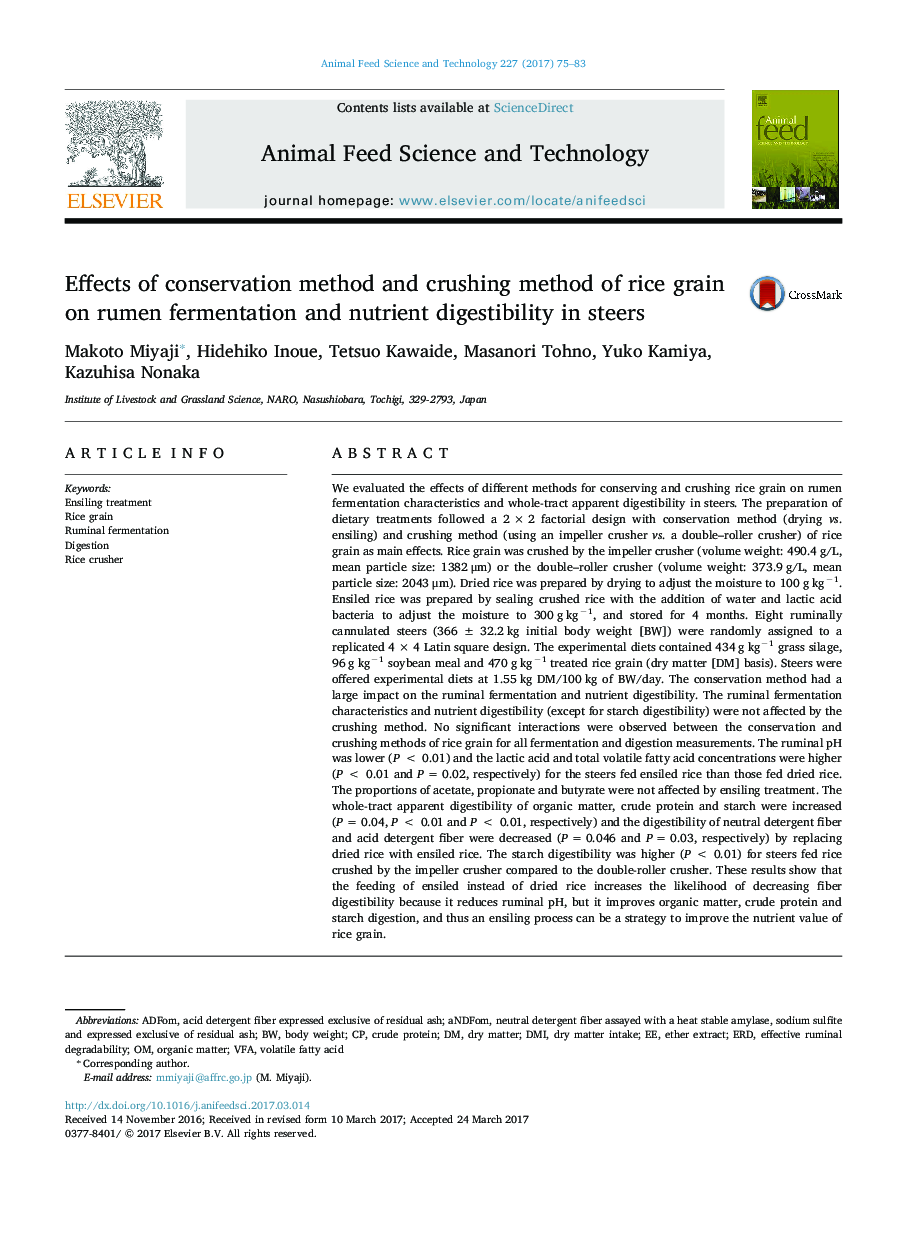| کد مقاله | کد نشریه | سال انتشار | مقاله انگلیسی | نسخه تمام متن |
|---|---|---|---|---|
| 5538737 | 1552359 | 2017 | 9 صفحه PDF | دانلود رایگان |
عنوان انگلیسی مقاله ISI
Effects of conservation method and crushing method of rice grain on rumen fermentation and nutrient digestibility in steers
ترجمه فارسی عنوان
اثر روش حفاظت و روش خرد کردن دانه برنجی بر فرآوری گوگرد و هضم غذایی مغذی ها در انگور
دانلود مقاله + سفارش ترجمه
دانلود مقاله ISI انگلیسی
رایگان برای ایرانیان
کلمات کلیدی
VFAeffective ruminal degradabilityaNDFomERDADFomDMIvolatile fatty acid - اسید چرب فرارacid detergent fiber expressed exclusive of residual ash - الیاف پاک کننده اسید بیانگر غلظت خاکستر باقی مانده استRuminal fermentation - تخمیر شفافRice grain - دانه برنجether extract - عصاره اترorganic matter - ماده آلیdry matter - ماده خشکdry matter intake - مصرف ماده خشکbody weight - وزن بدنcrude protein - پروتئین خامDigestion - گوارش یا هضم یا تحلیل
موضوعات مرتبط
علوم زیستی و بیوفناوری
علوم کشاورزی و بیولوژیک
علوم دامی و جانورشناسی
چکیده انگلیسی
We evaluated the effects of different methods for conserving and crushing rice grain on rumen fermentation characteristics and whole-tract apparent digestibility in steers. The preparation of dietary treatments followed a 2 Ã 2 factorial design with conservation method (drying vs. ensiling) and crushing method (using an impeller crusher vs. a double-roller crusher) of rice grain as main effects. Rice grain was crushed by the impeller crusher (volume weight: 490.4 g/L, mean particle size: 1382 μm) or the double-roller crusher (volume weight: 373.9 g/L, mean particle size: 2043 μm). Dried rice was prepared by drying to adjust the moisture to 100 g kgâ1. Ensiled rice was prepared by sealing crushed rice with the addition of water and lactic acid bacteria to adjust the moisture to 300 g kgâ1, and stored for 4 months. Eight ruminally cannulated steers (366 ± 32.2 kg initial body weight [BW]) were randomly assigned to a replicated 4 Ã 4 Latin square design. The experimental diets contained 434 g kgâ1 grass silage, 96 g kgâ1 soybean meal and 470 g kgâ1 treated rice grain (dry matter [DM] basis). Steers were offered experimental diets at 1.55 kg DM/100 kg of BW/day. The conservation method had a large impact on the ruminal fermentation and nutrient digestibility. The ruminal fermentation characteristics and nutrient digestibility (except for starch digestibility) were not affected by the crushing method. No significant interactions were observed between the conservation and crushing methods of rice grain for all fermentation and digestion measurements. The ruminal pH was lower (P < 0.01) and the lactic acid and total volatile fatty acid concentrations were higher (P < 0.01 and P = 0.02, respectively) for the steers fed ensiled rice than those fed dried rice. The proportions of acetate, propionate and butyrate were not affected by ensiling treatment. The whole-tract apparent digestibility of organic matter, crude protein and starch were increased (P = 0.04, P < 0.01 and P < 0.01, respectively) and the digestibility of neutral detergent fiber and acid detergent fiber were decreased (P = 0.046 and P = 0.03, respectively) by replacing dried rice with ensiled rice. The starch digestibility was higher (P < 0.01) for steers fed rice crushed by the impeller crusher compared to the double-roller crusher. These results show that the feeding of ensiled instead of dried rice increases the likelihood of decreasing fiber digestibility because it reduces ruminal pH, but it improves organic matter, crude protein and starch digestion, and thus an ensiling process can be a strategy to improve the nutrient value of rice grain.
ناشر
Database: Elsevier - ScienceDirect (ساینس دایرکت)
Journal: Animal Feed Science and Technology - Volume 227, May 2017, Pages 75-83
Journal: Animal Feed Science and Technology - Volume 227, May 2017, Pages 75-83
نویسندگان
Makoto Miyaji, Hidehiko Inoue, Tetsuo Kawaide, Masanori Tohno, Yuko Kamiya, Kazuhisa Nonaka,
